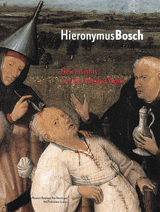
Janssen e.a. 2001
“Everyday Objects in the Paintings of Hieronymus Bosch” (Hans Janssen, Olaf Goubitz en Jaap Kottman) 2001
[in: Jos Koldeweij, Bernard Vermet and Barbera van Kooij (eds.), Hieronymus Bosch. New Insights Into His Life and Work. Museum Boijmans Van Beuningen-NAi Publishers-Ludion, Rotterdam, 2001, pp. 170-191]
The aim of this contribution is to find out whether the everyday objects depicted by Bosch match the similar objects that we know from archaeological excavations, especially the excavations that have been carried out in ’s-Hertogenbosch since 1977. The text consists of three parts. In the first (and by far largest) part Hans Janssen deals with objects made of pottery and metal. He begins with the objects that Bosch depicted in correct proportions to the acting human figures. In some cases they only form a functional part of this action and are not always depicted in a correct way. But in other cases they often have a negative, symbolical meaning and then they are depicted in a more realistic way. An example of this are the funnels that Bosch painted on the head of squanderers, swindlers, drunkards or fools. Other objects of this kind are: flesh hooks, flutes and drums, horns, helmets, armour and weapons, drinking vessels and jugs.
Bosch also often depicts objects that have been deliberately enlarged: knives, skates, bells, keys, cauldrons, lanterns, pitchers and jugs. Bosch sometimes painted a capital M on his giant knives. From archaeological excavations in ’s-Hertogenbosch we know one knife which also clearly shows an M: no doubt this was the mark of the craftsman who made the knife. What is striking about the M on the two knives of the right wing of the Garden of Delights, is that the mark is on the wrong side of the blade, namely on the right. Normally a knife’s mark should be on the left side of the blade close to the handle. Bosch often painted jugs in a sexual surrounding, which gives rise to the suspicion that horizontal jugs (with a clearly visible opening) are female sexual symbols, whereas jugs that are standing upright should be seen as male sexual symbols.
Janssen is able to point out real late-medieval equivalents for a number of the everyday objects that were painted by Bosch. The most striking examples of these are the knife carrying an M and some pitchers and jugs. It is not always clear, though, whether any deeper insights can be gained from this. The archaeological findings don’t yield any reliable conclusions regarding the dating of Bosch’s paintings because the datings of the archaeological findings themselves are too vague or too broad. Neither can the more or less realistic rendering of everyday objects provide us with a reliable standard to distinguish authentic works by Bosch from the work of imitators or pupils. This is nicely illustrated when Janssen compares the funnel beaker on the Rotterdam Saint Christopher with a similar funnel beaker in the Vienna Treeman drawing. Janssen suggests that the drawing is not authentic because the handle of the beaker has been wrongly depicted. An excavated funnel beaker indeed shows a handle in the same place as is the case with the beaker on the Rotterdam painting. But does this automatically mean that around 1500 there were no beakers with a handle like in the drawing? Maybe by coincidence such beakers have not been excavated (yet)?Furthermore, when Janssen deals with the symbolical meaning of everyday objects with Bosch, too often he relies on Dirk Bax’s interpretations in an uncritical way.
In the second part of this contribution Jaap Kottman discusses glass everyday objects with Bosch, such as drinking vessels, spectacles, windowpanes, mirrors and small jugs. The most striking observation here is that the small glass jug dangling from the walking frame of a diabolical monster on the right wing of the St. Anthony triptych (Lisbon) is more than likely a feeding bottle for babies (which perfectly matches the context of the walking frame and the baby clothes worn by the devil). In the third and last part Olaf Goubitz deals with the everyday objects of an organic nature. He mainly discusses different types of footwear.
[explicit]